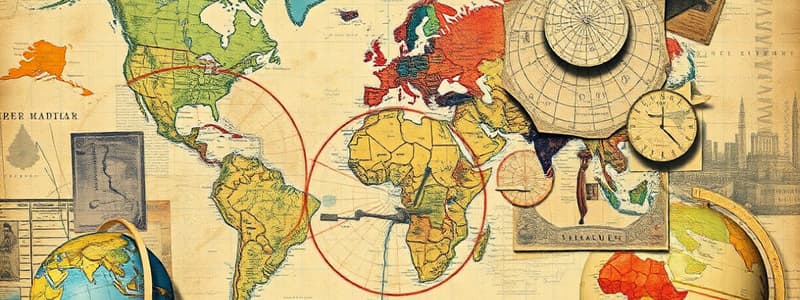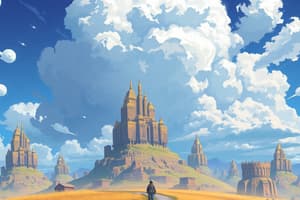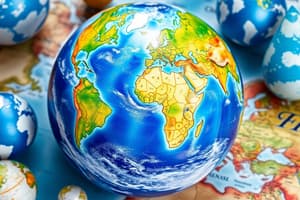Podcast
Questions and Answers
Which of the following are NOT considered a type of weathering?
Which of the following are NOT considered a type of weathering?
- Geological Weathering (correct)
- Mechanical Weathering
- Chemical Weathering
- Biological Weathering
What is the difference between a nation and a state?
What is the difference between a nation and a state?
- A nation is a group of people with a shared culture, while a state is a political entity with defined borders. (correct)
- A nation is a country with a strong economy, while a state is a country with a weak economy.
- A nation is a country with a strong military, while a state is a country with a weak military.
- A nation is a political entity with defined borders, while a state is a group of people with a shared culture.
Which of the following is NOT a factor that can influence the change in culture?
Which of the following is NOT a factor that can influence the change in culture?
- War
- Climate (correct)
- Trade
- Migration
What is the name of the original continent according to the theory of continental drift?
What is the name of the original continent according to the theory of continental drift?
Which of the following statements correctly describes the relationship between latitude and temperature?
Which of the following statements correctly describes the relationship between latitude and temperature?
Flashcards
Absolute Location
Absolute Location
The exact position of a place using coordinates (latitude and longitude).
Continental Drift
Continental Drift
The theory that continents were once a single landmass and have since drifted apart.
Climate Factors
Climate Factors
Two main factors that define a climate are temperature and precipitation.
Ecosystem
Ecosystem
Signup and view all the flashcards
Latitude
Latitude
Signup and view all the flashcards
Study Notes
Chapter 1: Introduction to Geography
-
Geography is the study of the Earth's surface, its people, and the interactions between them.
-
Five themes of geography: Location, Place, Human-Environment Interaction, Movement, and Region.
-
Absolute location is a precise point on Earth using coordinates (latitude and longitude).
-
Relative location describes a place in relation to other places.
-
A hemisphere is half of the Earth.
-
The equator and prime meridian are crucial for identifying hemispheres.
-
Latitude measures distance north or south of the equator.
-
Longitude measures distance east or west of the prime meridian.
-
Globes provide a true representation of the Earth's shape and size, unlike maps.
-
Maps have certain limitations (distortion).
-
Maps can show specific features and concepts (thematic maps).
-
Globes are the closest to an accurate representation of the real world.
-
Different map types include political, physical, and thematic maps, etc.
-
A method to reduce distortion on maps is using conic projections.
-
An example of a thematic map can be a map showing population density of an area.
-
The absolute location located at (-35, -120) is in the state of California (Assuming this latitude and longitude coordinates are on the United States map)
Chapter 2: Earth's Dynamic System
- Continental drift theory suggests that continents were once joined and have moved over time.
- The original supercontinent was known as Pangaea.
- Ocean currents (currents from the wind) and ocean tides are examples of ocean movements.
- Plate tectonics describes the movement and interaction of Earth's lithospheric plates.
- Plate movements can cause convergent boundaries (collision), divergent boundaries (seperation), and transform boundaries (sliding).
- Earthquakes occur along faults where tectonic plates meet.
- Volcanoes form when magma rises to the Earth's surface and erupts.
- The Ring of Fire is an area around the Pacific Ocean associated with high volcanic and seismic activity due to plate interactions.
- Weathering is the process of breaking down rocks and minerals by natural forces.
- Types of weathering can include mechanical weathering (physical breakdown) and chemical weathering (chemical alteration).
- Weathering shapes landscapes and changes the appearance of the Earth's surface.
Chapter 3: Climate and Ecosystems
- Climate is defined by average weather patterns over a long period.
- Two main factors defining climate are temperature and precipitation (rain and snow).
- Different climate zones have distinct characteristics (like tropical, temperate, or polar).
- An ecosystem is a community of organisms interacting with each other and their environment.
Chapter 4: Culture and Society
- Culture encompasses the shared beliefs, values, customs, and behaviors of groups of people.
- Societies and ethnic groups differ in various factors, such as language, traditions, and religion.
- Culture can change due to factors such as migration, innovation, and globalization.
- Language plays a fundamental role in transmitting culture and shaping societal views.
- Different types of religions exist globally (e.g., Christianity, Islam, Buddhism).
- Birthrates, fertility rates, mortality rates, and infant mortality rates influence population growth.
- Population density can be a concern related to resource availability and carrying capacity.
- A state is a political entity with a defined territory and government; a nation is a group of people with a shared identity and culture; a nation-state combines these two.
- Different types of governments exist worldwide (e.g., democracy, monarchy, dictatorship).
- Size, shape, and location influence a nation's development and interactions.
- National boundaries can be physical or political.
Studying That Suits You
Use AI to generate personalized quizzes and flashcards to suit your learning preferences.




